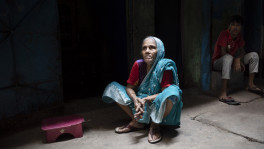The pandemic remade the Chinese economy
Other countries should prepare now for their own reformations.

China is the only large economy that posted positive growth in 2020. By the year's third quarter, GDP was back to its pre-pandemic and economic crisis level. The most recent indicators suggest that the country's economic rebound is gathering pace.
The most important factor in this remarkable performance has been the containment of the health crisis that started in Wuhan last December and now appears to be under control in China, fewer than 100 new cases being reported each day at the moment across the whole country. China was the first country to enter lockdown and the first to exit in March 2020. Unlike Europe or the United States, it has not experienced a second wave of contagion.
Despite a rather favorable economic and health situation, life in China is far from normal. The scars from the pandemic are running so deep as to prevent Chinese households from resuming their old consumption habits. Although factories reopened in the spring and returned to full capacity under government pressure, Chinese consumers have still limited their purchases almost exclusively to the essential. Higher unemployment, falling incomes, and fear of contagion are weighing on consumption.
To see the decoupling between the supply side and the demand side of the Chinese economy, it is helpful to look at rail traffic, which is a key variable in understanding the underlying dynamics. Before the COVID-19 pandemic, and given the unreliability of official GDP numbers, freight and passenger rail traffic was widely watched by China analysts to gauge changes in industrial production activity and in private consumption, respectively. When final goods leave a factory, they are shipped across the country for domestic purchases or to the closest port for export. Equally, Chinese citizens get on trains (more than planes) for high-end consumption like tourism or leisure—not to mention business trips.
After a slight contraction between January and March, freight rail traffic has since regained momentum and surpassed its pre-crisis levels. Passenger train traffic, on the other hand, contracted by 87 percent in annual terms in February, at the peak of the contagion in China, and has not returned to its pre-crisis level. In October, it was still down by around 15 percent compared with the same month in 2019. This indicator, which mostly represents business and leisure trips across the country, contrasts with data from the metro passenger rails, which showed a faster normalization in inner-city mobility.
Even though restrictions in China are now limited, people are still behaving very cautiously. They appear to be moving within cities for work and shopping but limiting leisure activities and tourism—or they are resorting to private transportation or closer tourist attractions. The first implication is that the fear of contagion continues to take its toll on social life even several months past the peak of infections. Keeping the number of new coronavirus cases low is not enough to generate a strong rebound in social consumption.
Having faced two pandemics in less than 20 years, SARS in 2003 and COVID-19 now, it makes sense that Chinese consumers are especially prudent. Once fear dissipates thanks to a mass vaccination campaign, they might return to their old habits.
But the slow return to normality poses broader and more fundamental questions about the aftermath of the crisis. Months of mandated or self-imposed restrictions might permanently change habits and social consumption patterns. Performing an action for the first time requires planning and attention. As behaviors are repeated in consistent settings, they become routine. According to some economic studies on habit formation, on average it takes around two months for human beings to form a new habit.
Even if we live in a fast-changing world, we are all trapped in "habit loops" that involve a cue, an action, and a reward. We go shopping at specific moments of the day or dine out on specific days of the week. People tend to be risk averse even when the transition costs for their daily tasks are low—what behavioral economists call status quo bias. To win this inertia, a more or less intense shock is necessary to make or break a habit. If the cue that triggers a specific behavior changes because of a new lifestyle (be it voluntarily or not), then our routine also changes.
Smart working arrangements, for example, do not just kill daily commuting. They also kill many cues that used to induce a certain kind of spending on the way to the office or back home. Not only are Chinese consumers traveling less by train, but they are also eating out less frequently and purchasing goods and services online more voraciously than before. In the third quarter, the consumption of educational, cultural, and entertainment services was still around 20 percent lower than a year earlier. And China's e-commerce and food delivery giants, such as Alibaba and Meituan Dianping, are reaping the benefits of an increasing number of consumption going online.
Even when life truly normalizes, some of these spending shifts might become permanent. The 2003 SARS outbreak in China, for example, is often credited with accelerating a structural shift to e-commerce and e-payments, leading to the emergence of some domestic giants in the sector. Similarly, the oil shocks of the 1970s forced consumers and firms to adopt energy-efficient practices, thus structurally reducing oil demand.
Likewise, rail traffic might be structurally affected by the COVID-19 pandemic, both in terms of a reduction in business trips due to the widespread use of videoconferencing and changing tourist habits. As a result, consumer spending might shift toward durable goods suitable for short-distance trips, such as electric vehicles, which Beijing was incentivizing even before the pandemic. Other sectors could face similar expenditure-switching effects.
The structural legacy of COVID-19 could be a reallocation of resources among and within sectors that could prevent an immediate return to full potential even when herd immunity is reached as some production capacity remains unused. But, in the long term, a more efficient resource allocation away from sectors that benefited from some behavioral inertia might boost productivity and increase the growth potential of the economy.
Since China is at an advanced stage in the fight against the virus, its experience can offer lessons for other countries looking to understand the post-coronavirus world. Some firms will be forced out of the market after months of curbed or frozen activity, while others will adapt their business models to a changed landscape. The pandemic is a sufficiently long and intense socioeconomic experiment to lastingly transform consumers' tastes as well.
Edoardo Campanella is a Future World fellow at IE University's Center for the Governance of Change in Madrid and the co-author, with Marta Dassù, of Anglo Nostalgia: The Politics of Emotion in a Fractured West.
Disclaimer: This opinion first appeared on Foreign Policy.


 Keep updated, follow The Business Standard's Google news channel
Keep updated, follow The Business Standard's Google news channel
















